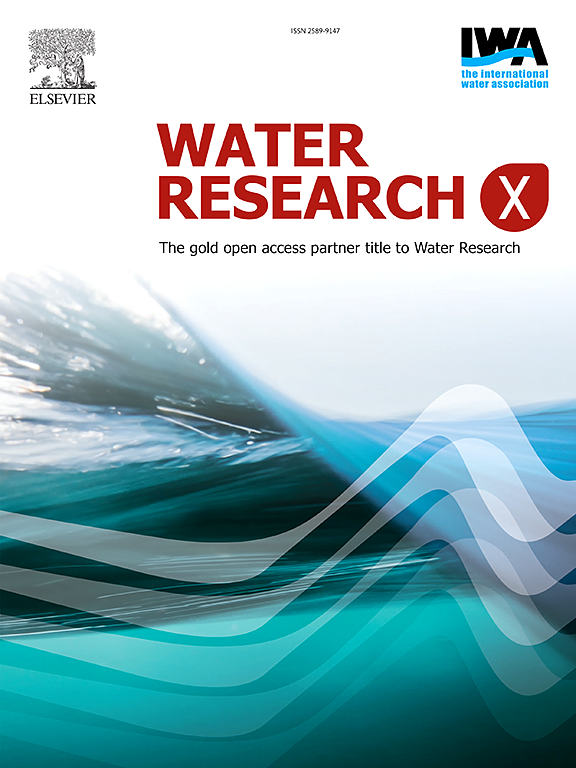韩国饮用水处理厂42种遗留和新出现的全氟烷基和多氟烷基物质(PFAS)的发生和清除情况
IF 8.2
2区 环境科学与生态学
Q1 ENGINEERING, ENVIRONMENTAL
引用次数: 0
摘要
本研究调查了洛东江流域饮用水处理厂原水和处理水中的42种全氟烷基和多氟烷基物质(PFAS)。在原水和处理水中均检测到22种PFAS,特别是6:2氟端聚体羧酸(6:2 FTCA), n-甲基全氟辛烷磺酰胺乙醇(N-MeFOSE),六氟环氧丙烷二聚酸(Gen-X)在韩国原水中首次被鉴定出来。在原水中,PFAS的浓度范围为13.3至189 ng/L,短链PFAS的含量高于长链PFAS。无论河岸过滤与否,浓度均无显著差异。在处理过的水中,77.8%的样品超过了PFOA的MCL (4 ng/L, US, EPA)。该研究评估了PFAS在不同处理过程中的去除情况,并表明除了最初的目标外,还可能存在其他前体。碳链越长,活性炭的去除率越高,PFBA的去除率为1.0±19.0%,PFDA的去除率为100±0%。相比之下,预臭氧化和臭氧化一般无效,总PFAS去除效率分别为-8.1±43.0%和6.1±34.7%。氯化处理的去除率也很低,在某些情况下,处理后PFHxS和PFOS的浓度增加,表明前体化合物的潜在影响。这些发现强调了进一步研究未知前体及其在PFAS转化中的作用的必要性。本文章由计算机程序翻译,如有差异,请以英文原文为准。
Occurrence and removal of 42 legacy and emerging per- and polyfluoroalkyl substances (PFAS) in drinking water treatment plants in South Korea
This study investigated 42 Per- and polyfluoroalkyl substances (PFAS) in raw and treated water from drinking water treatment plants in the Nakdong River basin. 22 PFAS were detected in both raw and treated water, especially 6:2 fluorotelomer carboxylic acid (6:2 FTCA), N-methyl perfluorooctanesulfonamidoethanol (N-MeFOSE), hexafluoropropylene oxide dimer acid (Gen-X) were identified for the first time in the raw water in South Korea. In raw water, PFAS concentrations ranged from 13.3 to 189 ng/L, with short-chain PFAS showing higher levels than long-chain PFAS. No significant difference in concentration was observed regardless of riverbank filtration. In treated water, 77.8 % of samples exceeded the MCL for PFOA (4 ng/L, US, EPA). The study assessed PFAS removal across various treatment processes and suggests the potential presence of additional precursors beyond those initially targeted. GAC showed increased removal efficiency with longer carbon chains, ranging from 1.0 ± 19.0 % for PFBA to 100 ± 0 % for PFDA. In contrast, pre-ozonation and ozonation were generally ineffective, with overall PFAS removal efficiencies of -8.1 ± 43.0 % and 6.1 ± 34.7 %, respectively. Chlorination also exhibited low removal efficiency, and in some cases, concentrations of PFHxS and PFOS increased post-treatment, suggesting the latent influence of precursor compounds. These findings highlight the need for further investigation into unidentified precursors and their role in PFAS transformation.
求助全文
通过发布文献求助,成功后即可免费获取论文全文。
去求助
来源期刊

Water Research X
Environmental Science-Water Science and Technology
CiteScore
12.30
自引率
1.30%
发文量
19
期刊介绍:
Water Research X is a sister journal of Water Research, which follows a Gold Open Access model. It focuses on publishing concise, letter-style research papers, visionary perspectives and editorials, as well as mini-reviews on emerging topics. The Journal invites contributions from researchers worldwide on various aspects of the science and technology related to the human impact on the water cycle, water quality, and its global management.
 求助内容:
求助内容: 应助结果提醒方式:
应助结果提醒方式:


